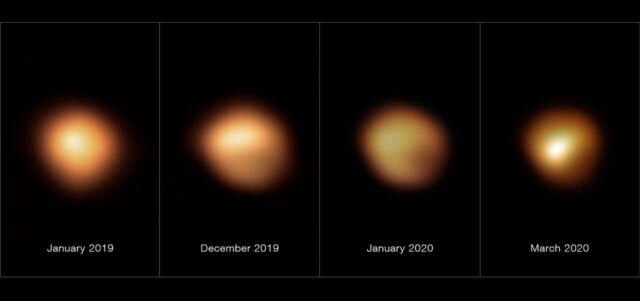In December 2019, astronomers noticed a strange, dramatic dimming in the light from Betelgeuse, a bright red star in the Orion constellation. They puzzled over the phenomenon and wondered whether it was a sign that the star was about to go supernova. Several months later, they had narrowed the most likely explanations to two: a short-lived cold patch on the star's southern surface (akin to a sun spot), or a clump of dust making the star seem dimmer to observers on Earth. We now have our answer, according to a new paper published in the journal Nature. Dust is the primary culprit, but it is linked to the brief emergence of a cold spot.
As Ars' John Timmer reported last year, Betelgeuse is one of the closest massive stars to Earth, about 700 light years away. It's an old star that has reached the stage where it glows a dull red and expands, with the hot core only having a tenuous gravitational grip on its outer layers. The star has something akin to a heartbeat, albeit an extremely slow and irregular one. Over time, the star cycles through periods when its surface expands and then contracts.
One of these cycles is fairly regular, taking a bit over five years to complete. Layered on that is a shorter, more irregular cycle that takes anywhere from under a year to 1.5 years to complete. While they're easy to track with ground-based telescopes, these shifts don't cause the sort of radical changes in the star's light that would account for the changes seen during the dimming event.
In late 2019, Betelgeuse dimmed so much that the difference was visible to the naked eye. The dimming persisted, decreasing in brightness by 35 percent in mid-February, before brightening again in April 2020.
Telescopes pointed at the giant were able to determine that—rather than a tidy, uniform drop in luminance—Betelgeuse's dimming was unevenly distributed, giving the star an odd, squished shape when viewed from Earth. That raised lots of questions about what was going on with the giant, with some experts speculating that because of Betelgeuse's size and advanced age, the strange behavior was a sign of a supernova in the making.
By mid-2020, astronomers had changed their tune. An international team of observers happened to have the Hubble Space Telescope pointed at Betelgeuse before, during, and after the dimming event. Combined with some timely ground observations, this UV data indicated that a big burp that formed a cloud of dust near the star may have caused the star to get darker.
"With Hubble, we could see the material as it left the star's surface and moved out through the atmosphere, before the dust formed that caused the star to appear to dim," said Andrea Dupree, an astronomer at the Harvard-Smithsonian Center for Astrophysics who made those observations. She is also a co-author on the new paper.

The findings last year showed that an outer layer of the star, called the photosphere, had begun unevenly accelerating outward right before Betelgeuse began to dim. At its peak, the photosphere was moving at around 7 kilometers per second, reversing the outward push as the dimming of the star became more dramatic.
Dupree and her colleagues suggested that as the star expanded in one of its usual cycles, a portion of the surface accelerated much more rapidly, thanks to a convection cell that had traveled from the interior of the star to its surface. Those two events combined pushed out sufficient material far enough from the star that it cooled down, forming stardust. That dust could account for the dimming.
The new Nature paper expands on those earlier observations due to images captured by the European Southern Observatory's (ESO) Very Large Telescope (VLT) in January and March 2020. "For once, we were seeing the appearance of a star changing in real time on a scale of weeks," said co-author Miguel Montargès, from the Observatoire de Paris, France, and KU Leuven, Belgium.
Those images, combined with earlier observations in January and December 2019, allowed astronomers to directly witness the stardust formation, matching the observations of Dupree and her colleagues last year. The ESO team concluded that a gas bubble was ejected and pushed further out by the star's outward pulsation. When a convection-driven cold patch appeared on the surface, the local temperature decrease was sufficient to condense the heavier elements (like silicon) into solid dust, forming a dusty veil that obscured the star's brightness in its southern hemisphere. The astronomers speculate that a similar expelling of dust from cool stars could end up becoming building blocks of planets.
The ESO team found no evidence to support the impending supernova hypothesis. "The lack of an explosive conclusion might seem disappointing, but [these] results go beyond explaining one brief wink of a nearby star," University of Washington astronomer Emily Levesque (who is not a co-author) wrote in an accompanying Nature commentary. She raises the prospect of other red supergiants also showing signs of dimming. "Next-generation facilities focused on monitoring stellar brightness over time, or on studying the signature of dust in the infrared spectra of stars, could prove invaluable for expanding the lessons learned here."
One of those next-generation facilities is ESO's Extremely Large Telescope (ELT), slated to achieve first light in 2026. "With the ability to reach unparalleled spatial resolutions, the ELT will enable us to directly image Betelgeuse in remarkable detail," said co-author Emily Cannon of KU Leuven. "It will also significantly expand the sample of red supergiants for which we can resolve the surface through direct imaging, further helping us to unravel the mysteries behind the winds of these massive stars."
DOI: Nature, 2021. 10.1038/s41586-021-03546-8 (About DOIs).
Listing image by ESO/M. Montargès et al.
Article From & Read More ( A cold spot and a stellar burp led to strange dimming of Betelgeuse - Ars Technica )https://ift.tt/3zwRui8
Science
No comments:
Post a Comment